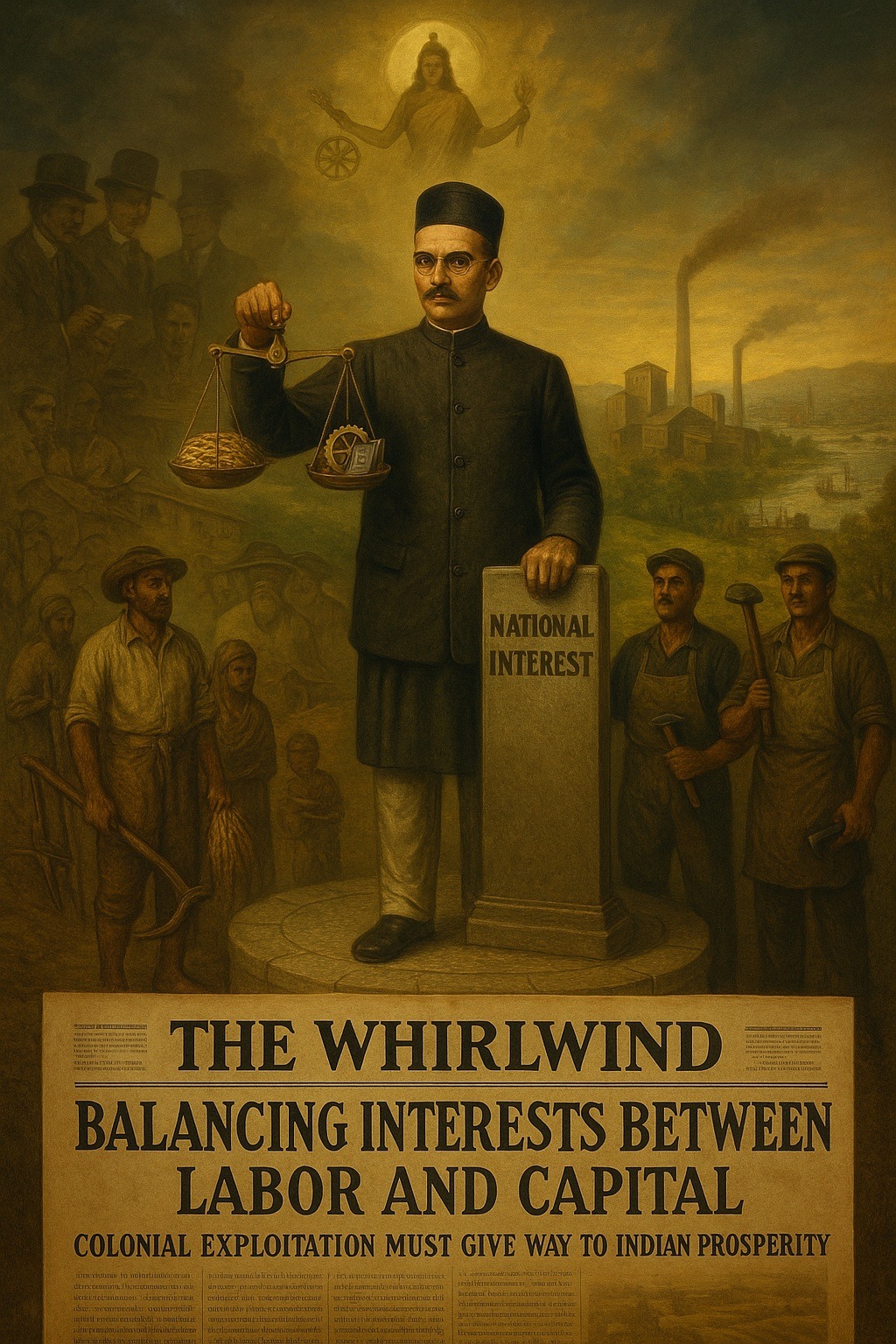Economic Dimension of Hindutva, Part 9; Savarkar’s Economic Principles (5/13)
The balance between labor and capital has long been a subject of debate in economic and political thought. Vinayak Damodar (Veer) Savarkar, known for his nationalist and revolutionary ideas, also put forward an economic perspective that sought to harmonize the interests of labor and capital within the broader framework of national interest. According to Savarkar, this equilibrium should be carefully established to serve the needs of the nation as a whole.
Colonial Economic Exploitation and the Need for Reform
Savarkar keenly observed that British colonial rulers intentionally suppressed capital accumulation among local producers by enforcing systems of debt bondage and economic dependencies. These colonial policies hindered economic self-sufficiency and perpetuated a cycle of poverty among Indian laborers and farmers. Recognizing this as a critical impediment to national growth, Savarkar called for urgent corrective measures to restructure the economic conditions, particularly in the agricultural sector. He believed that capital was being excessively extracted from agriculture while investments were disproportionately channeled into industrial development.
Balancing Growth in Agriculture and Industry
Savarkar’s economic thought was not limited to agricultural reforms. He envisioned a strategic redistribution of investment to ensure equitable growth across both agriculture and industry. He argued that improving the socioeconomic conditions of workers should not be restricted to one sector alone but should extend to industrial laborers as well. By advocating for an allocation of investments that would stimulate both sectors, Savarkar sought to establish a more resilient and self-sustaining national economy.
Profit-Sharing and National Interest
A key tenet of Savarkar’s economic philosophy was the principle of profit-sharing, particularly concerning laborers and farmers. He believed that those who contributed to the nation’s economic output should receive a fair share of its wealth. However, he also emphasized that such participation must be guided by a balance of rights and responsibilities. While he did not outright reject the profit-sharing model, he cautioned that any demand for wealth distribution should not compromise national security or economic stability. This underscores his broader vision of an economy that is both inclusive and strategically sustainable.
Final Thoughts
Savarkar’s economic insights offer a nuanced approach to resolving conflicts between labor and capital. His emphasis on balancing these interests within the framework of national well-being remains relevant in contemporary discussions on economic development. By advocating for fair wealth distribution without undermining economic security, Savarkar sought to lay the foundation for a self-sufficient and prosperous nation. His ideas continue to inspire debates on how economies can achieve growth while ensuring social equity and national strength.
💭 What do you think? Should modern India prioritize agriculture or industry when planning for equitable growth — or strive for Savarkar’s balance? How might Savarkar’s principle of profit-sharing among laborers and farmers be applied in contemporary economic systems? Where do you see the biggest tension today between labor rights and capital interests in India (or globally)? Do you agree with Savarkar’s caution that wealth distribution must never undermine national security or stability? What lessons can policymakers today draw from Savarkar’s call for economic self-sufficiency under colonial exploitation? If you had to choose one — equity for workers or rapid national growth — which should take precedence, and why?
👉 Share your thoughts in the comments below!
Sources:
DESHPANDE, Sudhakar. 1999. Savarkar. The Prophetic Voice. Dastane Ramchandra & Co.: Pune.
KRÜGER, Horst. 1985. Anfänge sozialistischen Denkens in Indien. Der Beginn der Rezeption sozialistischer Ideen vor 1914. Band II. Akademie-Verlag: Berlin.
PATWARDHAN, V. S. 1989. „Savarkar’s Economic Thinking“, in PHAKE, Sudhir/PURANDARE, B. M. and Bindumadhav JOSHI. (Eds.). 1989. Savarkar. Savarkar Darshan Pratishtnah (Trust): Bombai (Mumbai), 118-122.
PHADTARE, T. C. 1975. Social and Political Thought of Shri V.D. Savarkar. A Thesis submitted to the Marathwada University for the Degree of Doctor of Philosophy. Unpublished: Aurangabad.
ROTHERMUND, Dietmar. 1985. Indiens wirtschaftliche Entwicklung. Von der Kolonialherrschaft bis zur Gegenwart. Schöningh (UTB): Paderborn.
ROTHERMUND, Dietmar. 1983. The Indian Economy under British Rule and other Essays. Manohar: New Delhi.
SAVARKAR, Vinayak Damodar .2007. Hindu Rashtra Darshan. Bharat Bhushan. Abhishek Publications: New Delhi.
SAVARKAR, Vinayak Damodar. 1945. Hindu Rashtravad. Being an Exposition of the Ideology & Immediate Programme of Hindu Rashtra as outlined by Swatantrayaveer V.D. Savarkar. Rohtas Printing Press: Rohtak. (Collected & Edited by Satya Parkash).
Wolf, Siegfried O. 2009. Vinayak Damodar Savarkar und sein Hindutva-Konzept. Die Konstruktion einer kollektiven Identität in Indien [“Vinayak Damodar Savarkar and his concept of Hindutva: The construction of a collective identity in India.”]. Online Dissertation: Heidelberg University: Heidelberg.


Leave a Reply